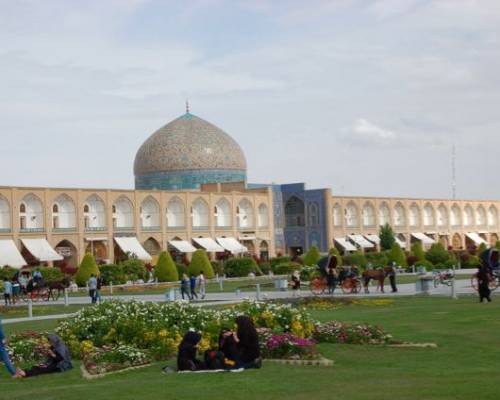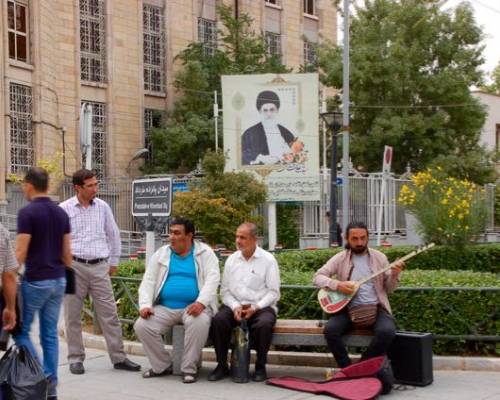Planning a trip to Iran? Read on....
19 May 2017 - RPS Partnership
Iran is one of those places to which everyone wants to go. But you are either too nervous, you believe the media reports and then you are too scared to go or you just think it is going to be plain difficult. So we asked our good friend and colleague, Charlie McGrath, of Objective Travel Safety, to tell us what it was like travelling there, the high points and the "need to knows". He has just returned from Iran where he took a holiday. HIs thoughts below make interesting reading. We've highlighted the TOP TIPS for you to note. Hope this is of interest to you. Let us know your thoughts on @rpspartnership (twitter) or Linkedin
Contact us for advice and training to go to tricky or difficult places on [email protected] Our next Hostile Environment Awareness Training (HEAT) or Hostile Environment Training (HET) course is 10-12 July. Contact us to reserve your place here.
Travelling in Iran
"I visited Iran for the first time in May 2017. What an amazing experience and the country lived up to all the hype I had heard, I can honestly say its one of the very best trip I have ever done" says Charlie.
The country is vast with ever topography, has a wealth of history and culture to see and the Iranians we met were just so friendly. The common western belief is that its full of fanatical religious zealots, but the reality is very different. Whilst clearly is still run by a religious elite for whom most people seem to have little time, the country is open to tourists, travelling is easy and Iran still retains a secular feel to it despite the daily signs of adherence to some quite strict Islamic dress and behaviour codes.
Getting There
All westerners need a visa but the process is clear and straightforward. For British, US and Canadian citizens it's a little more difficult, one has be escorted by a tour guide whilst in Iran and it's worth noting that the US and Canada still has no diplomatic representation in Iran.
The British embassy reopened in 2016, but being British is not a problem, everyone we met were delighted to see us, they wanted to practice their English and we met no hostility from any quarter.
To get a visa one needs to get a pre authorisation code from an Iranian travel agent. We used Iranian Tours, www.iraniantours.com who were quite excellent and I can highly recommend them. They also do a visa service, www.iranianvisa.com.
It might take up to 4 weeks to get the code but once you have it you can get a visa very quickly. The Iran consulate in London even offers a same day service for around £120.
Top tip: Women should wear headscarves when getting their visa from the consulate.
For those taking cars into Iran you must have a Carnet de Passage, it's the only country in Central Asia that you should need one. You might be able to get it on the border but we would advise getting it in advance. For Brits this can be got from Cars Europe, www.carseurope.net. For Germans you can get it from ADAC based in Munich. You will need to buy third party car insurance (the car is insured not the drivers). My son’s cost € 60, it should have been €80 but the official was also a Chelsea fan the power of the Premier League! Whilst on the subject of driving, petrol is cheap, 20p/L with 3 octane levels available. The roads are good but the standard of driving is very poor but we were assured it had improved and the police now rigorously enforce the speed limit on the motorways. The latter also have tolls, its not expensive.
Cultural Considerations
I mentioned that for a tourist Iran is not as repressive country as some preconceived ideas, however you have to dress appropriately.
Top tip: For men absolutely no shorts and women (and girls over 9) will have to wear a headscarf at all times.
You will see in the more western areas the women wear their headscarf’s as far back on their heads as possible. But headscarves should be worn at all times in public.
Accessing mosques was not a problem but as a non-Muslim we could not get into the central part of some of the holy shrines. Iran is unlike most other Muslim countries, the women readily shake hands and we had a constant stream of girls and women wanting to be photographed with us, I suspect more out of curiosity rather than our good looks!
Naturally we tried to stay off politics but it was the elections approaching scores of people we met expressed delight at us being in Iran but were not exactly complimentary about their government.
Top tip: Rather left of field, the thumbs up sign has the opposite meaning in Iran although most Iranians (due to the social media ‘like’ symbol) understand its meant with good intention.
Practical Advice
Top tip: Leave your Visa and Mastercard behind! You must have cash.
Due to the sanctions imposed by the 5 + 1 countries & in particular these card companies being American, they can’t be used.
As for which currencies either US Dollars or Euros probably best but Pounds Sterling are readily changeable, you can change in registered exchange offices, hotels or often on the street.
You need to have a very good understanding of the exchange rate and be firm if changing on the street as they often quote a rate and amount but then try to give you slightly less due to their commission.
Top tip: A rate and amount agreed is the deal, walk away if they try to play the commission card. The currency, the Iranian Rial (IRR), is a closed currency so you are not be able to buy in advance. What is confusing is that prices are often expressed in either Rials or Toman.
One Toman is 10 Rials, so a course in a restaurant might be listed as 34,000 Rial but the waiter might quote 3,400 Toman. Tomans are occasionally called Khomeini as the Ayatollah was on the bank note.
Food, hotels and the internet
Iran is relatively cheap; a good meal might be £8 or £10 per head. There are hotels of all standards and the standard is good. All good hotels will have internet although some are restricted to the reception area. Speeds vary, we were told that the government had increased speeds as the election was approaching.
The BBC & CNN are blocked but not the Guardian or Times. The Government tries to control access but it's clear that most Iranians use VPNs to get around the restrictions.
Satellite dishes are also banned in theory but again most locals have them and it seems the government is losing the control battle. We couldn’t download new books onto a Kindle, I imagine that due to sanctions Amazon has blocked any Iranian IP addresses, so do all your downloading before you pack your bags! Apart from hotels wanting to retain your passports, we experienced no other official controls.
It should be remembered that Iran is in a major earthquake zone and Iranians often express concern. The main focus of worry is Tehran, which I understand, is built on 2 fault lines and should there be a severe quake, casualties are expected in the 100s of thousands due to poor building codes (or their enforcement).
Top tip: if you are concerned about earhquakes, try to stay in a more modern hotel and make sure your party understand the threat and some actions that might improve survival chances.
What to see
There is so much, my advice is try to see more than just the well know sites such as Shiraz, Esfahan, Mashhad and Persepolis.
These are all amazing but so are the mosques and bazaars in Tabriz and Zanjan and the countryside around Takht-e-Soleiman (and the volcano plug) in the north west for example.
Top tip: Do take a paper map with you so you can plan routes off the motorways and through the mountains. The road from Esfahan to Shiraz via Vasuj is truly spectacular. So much of the charm of Iran is pottering in the bazaars and one doesn’t get hassled in the same way as one might in Turkey or India.
Tehran is large and polluted, using the metro is a good way of getting about.
The Holy war (Iran - Iraq war) museum is quite excellent as, I understand, is the Jewelry museum.
Top tip: If you want to get away from the smog go to the northern end of the red metro line and visit the bazaar and restaurants in the Darband area.
Skiing
Between December and April the resorts of Dizin and Shemshak near Tehran are open to skiers. There are also runs near Tabriz and the Zagros mountains in the Shiraz area.
Allow yourself 2 weeks in order to see a decent chunk of this extraordinary country.
NOTE: Take note that from a planning perspective, if you need to travel to the US in the near future and rely on an ESTA, it is worth knowing that it will be cancelled and you'll need to apply for a visa, so leave yourself time to do that.
Wow - amazing we say at RPS Partnership. Sounds like an interesting place to go travelling. Contact us for any training or advice on travel to Iran or anywhere else you are not sure of. We run specialist Lone Female Traveller workshops if you would like to enquire [email protected]
Photos: Iran with thanks to Charlie McGrath of Objective Travel Safety



